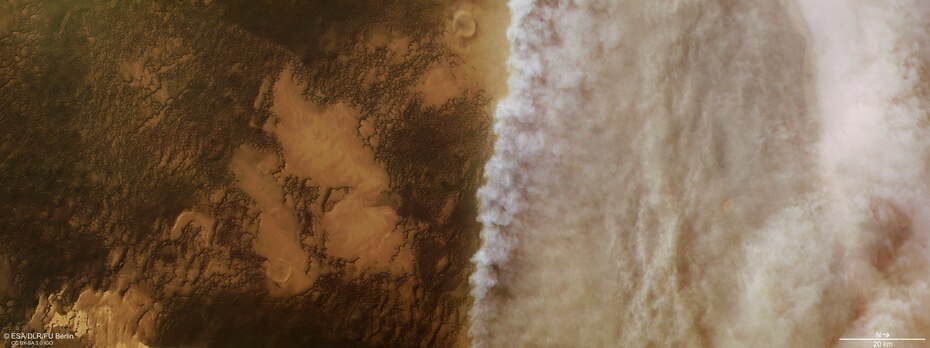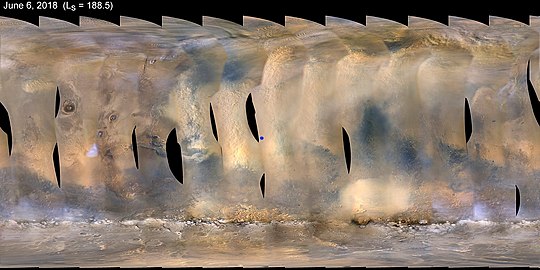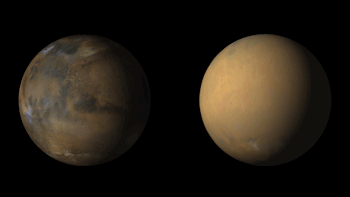Dust storm (mars)
Dust storms on Mars reach high wind speeds of around 100 km / h due to the thin Martian atmosphere (approx. 1.2% of the density of the earth's atmosphere) , but only a low wind pressure . So their intensity is much lower than that of storms on Earth. However, they can expand over large areas and even envelop the entire planet.
Current research is concerned with finding out when and under what conditions global dust storms occur on Mars.
overview
In the left half of the picture, the typical landscape of the northern subpolar plains can be seen, in which numerous dune fields have formed. At the end of May another, much larger storm developed southwest of it in Arabia Terra , in the transition area from the northern lowlands to the southern Martian highlands, which developed into a global, planet-wide dust storm within a few weeks. This was one of the strongest dust storms ever observed on Mars.
Image width: approx. 200 km, north is on the right, ( Mars Express , April 3, 2018)
Strong winds , which often occur on Mars, can cause a small dust storm . These can expand into larger storms. Once a storm has arisen, it can last for weeks to months.
On average every three Martian years (approx. 5½ earth years), normal dust storms develop into global storms within a few weeks that envelop the entire planet. A global dust storm usually begins in the southern hemisphere. Blown dust is then transported to other parts of the planet by an intensified Hadley circulation . Dust storms found in the northern hemisphere do not appear to spread globally.
Emergence
When sunlight hits the ground, the air near the ground is warmed up while the upper layers of air remain cool. This makes the warm and cold air layers unstable. The warm air rises and takes the fine Martian dust with it. The lower surface gravity of Mars (38% of the earth's gravitational acceleration ) favors the ascent of the dust to greater heights.
Dust is brought into the atmosphere by several different mechanisms, including wind on the surface, dust devils, and saltation . These mechanisms depend on the size of the dust particles. In order for coarse-grained particles to rise through the saltation process, the wind speed must reach values between 25 and 30 meters per second. The saltation of dust that contains larger grains can cause finer particles to be lifted with it. This can subsequently lead to local, regional and global dust storms as these fine particles remain in the atmosphere longer. Since dust devils are relatively common on the surface of Mars, it has been suggested that they too could be responsible for raising all sizes of dust particles.
After the dust has reached the atmosphere, it can remain there for a few hours, days or, in the case of a local dust storm, for several days or weeks. Dust can be carried to other places on the planet by global circulation ( Hadley cells or planetary waves) or by mesoscale and local winds. The meridional ascending part of a Hadley cell lifts warm air up to 40 km during the southern summer and transports it to the northern hemisphere. The southward flow of a Hadley circulation was observed by MOC images in Mars year (MY) 24 when several regional dust storms occurred.
The mechanism that causes these planet-wide dust storms remains poorly understood. Dust in the air affects atmospheric temperature and has a significant effect on general circulation in the Martian atmosphere. Therefore, when modeling global climate models, the radiation effects of the Martian dust must be taken into account. During the day, the dust absorbs solar radiation and warms the lower atmosphere through diabatic heating . This could cause the dust z. B. affect the Hadley circulation. Compared to a dust-free atmosphere, an increase in the dust content of the atmosphere causes the meridional circulation to expand vertically and horizontally.
Larger dust storms usually occur during the summer of the Martian southern hemisphere. As on Earth, the seasons on Mars are caused by the inclination of the axis. However, the orbit of Mars is much more elliptical than that of Earth. As a result, the planet receives far more radiation near the sun than at a distance, and the southern summers are warmer than the northern summers. Scientists are not yet sure why there are so long periods between the occurrence of dust storms.
According to James Shirley of the Jet Propulsion Laboratory , global dust storms appear to be more likely to occur when Mars' orbital angular momentum increases. Other planets affect the momentum of Mars as it orbits the center of gravity of the solar system. The torque generated by the other bodies of the solar system varies with a cycle time of 2.2 years. This is longer than the orbital period of Mars, which is approximately 1.9 years. Shirley found that global dust storms occur when this torque increases during the first part of the dust storm season. None of the known global dust storms occurred in years when torque decreased during the first part of the dust storm season.
This physical hypothesis predicts that a weak coupling of the orbital and rotational motions of extended bodies (like other planets) can cause a modulation of circulation currents in their atmospheres. With this hypothesis, cycles of intensification and weakening of large-scale circulation flows are predicted, the phase position of these changes being directly linked to the rate of change of the orbital angular momentum with respect to the inertia frame. The hypothesis was confirmed by comparisons between calculated dynamic time series of the rate of change in orbital angular momentum and historical observations.
Course of a global dust storm
According to Gierasch (1974), the formation of a storm proceeds as follows: One or more regional storms develop during the southern Martian summer or spring in one of three preferred regions:
- in the sloping plains between the north-western edge of the Hellas Basin and the Noachis highlands ,
- in the plains to the west, south and southeast of Claritas Fossae,
- in the Isidis Planitia plain east of Syrtis Major .
These local dust storms continue to spread over a period of typically four days. During another four days, the expansion accelerates, new centers of activity develop as existing ones connect. At first, the storm expansion begins mainly in an east-west direction. After another 5 to 10 days the dust has taken over the entire planet. Many of the core regions that had built up during the initial stages remain active and are distinguishable during the later stages of the storm. As soon as a large dust storm has reached its final phase, the planet-wide haze recedes over a period of several weeks.
List of Martian storms
The following table lists examples of observed dust storms on Mars. Ten global dust storms have been detected since 1924. The actual number of such events is arguably higher. Before Mars was permanently monitored by Orbiters , observation was only possible with earth-based telescopes . However, during the season when the storms are most likely to occur, Mars is poorly positioned for observation.
| time | Martian year | Duration | Area | Remarks | L s | Area of origin |
|---|---|---|---|---|---|---|
| 1909 (Aug) | ||||||
| 1911 (Nov) | ||||||
| 1922 | 192 ° | |||||
| 1924 (Oct) | Global | Global dust storm in summer | ||||
| 1924 (Dec) | 237 ° | Isidis Planitia | ||||
| 1939 | Utopia ? | |||||
| 1941 (Nov) | South of Isidis | |||||
| 1943 | 210 ° | Isidis | ||||
| 1956 | MY1 | Global | Global dust storm in summer | 249 ° | Hellespontus | |
| 1958 | MY2 | 310 ° | Isidis | |||
| 1971 (Jul) | MY9 | 213 ° | Hellespontus | |||
| 1971 (Sep) | MY9 | Global | Observed on arrival of Mariner 9 , global dust storm in summer | 260 ° | Hellespontus | |
| 1973 | MY10 | Global | Global dust storm in summer | 300 ° | Solis Planum , Hellespontus | |
| 1977 (Feb) | MY12 | Global | Observed by Viking 1/2, global dust storm in spring | 205 ° | Thamasia Fossae | |
| 1977 (Jun) | MY12 | Observed by Viking 1/2 | 275 ° | |||
| 1979 | MY13 | 225 °? | ||||
| 1982 | MY15 | Global | Global dust storm in summer | 208 ° | ||
| 1994 | MY21 | Global | Global dust storm in summer | 254 ° | ||
| 2001 | MY25 | Global | Global dust storm in spring | 185 ° | ||
| 2007 | MY28 | Global | Observed by the rovers Spirit and Opportunity | |||
| 2012 | MY31 | |||||
| 2018 | MY34 | Global | Observed by the rovers Curiosity and Opportunity | 190 ° |
Web links
Individual evidence
- ^ German Aerospace Society: Yearbook . 2002 ( books.google.de ). : "The Martian atmosphere has a density of 0.016 kg / m³ (Earth 1.293 kg / m³)"
- ^ The Fact and Fiction of Martian Dust Storms. (No longer available online.) National Aeronautics And Space Administration, archived from the original on June 18, 2018 ; accessed on June 18, 2018 .
- ↑ James H. Shirley, Michael A. Mischna: Orbit-spin coupling and the interannual variability of global-scale dust storm occurrence on Mars. Retrieved August 15, 2018 .
- ↑ GIERASCH, PJ: Martian Dust Storms. (PDF) Retrieved July 22, 2018 .
- ^ Richard W. Zurek: Martian Great Dust Storms: An Update. (PDF) Retrieved July 22, 2018 .
- ↑ James H. Shirley, Michael A. Mischna: Orbit-spin coupling and the interannual variability of global-scale dust storm occurrence on Mars . In: Planetary and Space Science . tape 139 , April 16, 2016, p. 37-50 , doi : 10.1016 / j.pss.2017.01.001 , arxiv : 1605.01452 [abs] .
- ↑ Guy Webster, NASA: Study Predicts Next Global Dust Storm on Mars. NASA, October 5, 2016, accessed August 22, 2018 .




